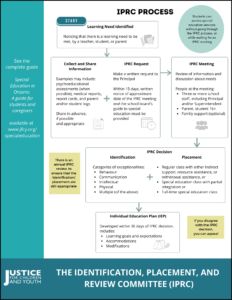- What is the Identification, Placement, and Review Committee (IPRC)?
- Identification
- Placement
- IPRC Flowchart
- Requesting an IPRC meeting
- Guide to special education
- Who will be at the IPRC meeting?
- Preparing for the IPRC meeting
- What is the Individual Educational Assessment for the IPRC?
- What should we expect at the IPRC meeting?
- The IPRC Statement of Decision
What is the Identification, Placement, and Review Committee (IPRC)?
The Identification, Placement and Review Committee (IPRC) is a formal group of school board staff that meet to make a decision about the identification and placement of the student.
The IPRC is made up of at least three (3) school board staff, including the Principal and/or Superintendent (sometimes called Supervisory Officer). Parents and students over 16 years of age have a right to attend the meeting.
I = Identification: deciding if the student is “exceptional”
P = Placement: deciding the best placement for the student
R = Review: deciding whether the Identification & Placement are still appropriate
C = Committee: the Principal (or Superintendent) & two other school staff
Once the IPRC has determined that a student is exceptional, they will make recommendations for the types of special education programs and services to meet the student’s needs. All publicly funded school boards in Ontario must have at least one designated IPRC. After the student has been identified as exceptional, the school board has 30 days to develop an Individual Education Plan (IEP).
Identification
The IPRC will decide whether a student has an exceptionality. Exceptionalities are categories of special needs that can affect how a student learns. Students are identified so they can be supported in meeting their full potential. Students with exceptionalities have unique learning needs, and school boards are required to support these needs. All students with demonstrable learning needs may access special education services; exceptionalities are meant to be broad categories that do not exclude any medical condition that can lead to learning difficulties.
There are five different categories of exceptionality in Ontario’s Education Act.
- Behaviour refers to challenges over a period of time, and to such a degree, that it impacts a student’s learning. For example: compulsive reactions, excessive fears, anxiety, difficulties with social interactions.
- Communication refers to challenges that impact a student receiving or relaying information. For example: Autism Spectrum Disorder, Deaf and Hard-of-Hearing, Language or Speech Impairment, Learning Disabilities (such as AD/HD, reading, writing, numbers, processing, fine motor skills).
- Physical refers to a condition that affects the body, where help is needed to support the student’s educational achievement. For example: a physical disability, Blind and Low Vision.
- Intellectual refers to differences in general mental or cognitive abilities – higher or lower – that may affect: intellectual functioning such as learning, problem solving, judgment, or adaptive functioning (activities of daily life), such as communication, or independent living. For example: Giftedness, Mild Intellectual Disability, Developmental Disability.
- Multiple refers to when a student’s needs are in two or more of the above categories of of exceptionality. For example: a student with Autism Spectrum Disorder, who is also gifted would be identified as living with multiple exceptionalities.
Placement
Once identified as having an exceptionality, the IPRC will determine what type of placement is best suited for the student. Placements refer to what type of educational setting would best meet the needs of an exceptional student. There are five types of special education placements:
- Regular class with indirect support: the student attends a regular classroom for the entire school day; and the teacher receives support from a special education teacher.
- Regular class with resource assistance: the student attends a regular classroom for the entire school day; and will get help from a special education teacher, either individually or in a small group.
- Regular class with withdrawal assistance: the student attends a regular classroom for more than half of the school day; and will will get help from a special education teacher outside of the regular classroom for part of the day.
- Special education class with partial integration: the student will be in a regular classroom less than half of the school day. The remaining part of the school day, the student will receive instruction outside the classroom from a special education teacher.
- Full-time special education class: the student will spend the entire day in a special education class
The student should always be placed in a regular classroom, except when this placement would not be able to meet their needs. Under these circumstances, the IPRC decision must explain the reason for the special education classroom placement.
Maximum class sizes for full-time special education classes differ, based on the level of need. For student with severe learning disabilities, the maximum is eight students in one class, with a qualified special education teacher. Mixed exceptionality classes may have up to 16 students with one teacher. For more information on special education classroom placements, see Regulation 298 of the Education Act, section 31.
In addition to the five placement options, the IPRC can also refer the student to one of the Provincial and Demonstration Schools. Students must meet eligibility requirements for admission to enter:
- into a provincial school for the blind, deaf, or deaf-blind, or
- a provincial demonstration school for students with severe learning disabilities.
- Learn more at www.pdsbnet.ca
IPRC Flowchart
Requesting an IPRC meeting
The role of the IPRC is to meet the needs of a student, once a unique learning need is identified. Learning needs can be identified by the student, their parent/caregiver, a teacher, the Principal, or other professionals who may support the student in their school career.
When a student is enrolled in an Ontario public school, parents and students 16+ have the right to request- in writing- an IPRC meeting. The Principal and board cannot refuse an IPRC request.
On request, all communication about the IPRC meeting must be available in Braille, large-print, or audio format.
Within 15 days of receiving a written request, or of the principal calling an IPRC, the principal must provide the following to the parent and student 16+:
- acknowledgement of the request
- a copy of the school board’s guide to special education
- an approximate date of when the IPRC will meet. The Principal must provide at least 10 days notice of the meeting date
The IPRC decision must be reviewed annually. You can also ask for a review after a student hast been placed for 3 months.
Guide to Special Education
Once a request for an IPRC meeting has been made, the principal must give the parent and student 16+ a copy of the school board’s guide to special education for parents, within 15 days. The guide is meant to support parents and students in understanding the IPRC process, special education, and what to expect. If you have not received a copy of your school board’s guide to special education, you can contact your Principal directly. The school board must also have it on their website. It is your legal right to be given a guide to special education prepared by your school board.
The Guide includes:
- The IPRC & appeals processes
- Exceptionalities and placement types
- Contact information for Provincial and Demonstration Schools
- Information for the school board’s Special Education Advisory Committee (SEAC) and which local organizations are eligible to take part
- Special education programs and services that are available through the school board
- Explanation of if a parent does not sign the consent form but does not appeal within the timelines, the IPRC decision can still be implemented
Who will be at the IPRC meeting?
There are always a minimum of three school staff present at the IPRC meeting, including either the Principal or Superintendent. Other school staff that may be there include:
- Resource teacher
- Classroom teacher
- Special education staff
- Social Worker
- School Psychologist
- Other school board professionals who provide support, or who may be able to provide further information
Other people who may attend include:
- Parent/caregiver(s)
- Student if 16+
- Representative of the parent(s) and/or of a student 16+ (to advocate, speak on behalf of, take notes for, etc.)
- Interpreter (including sign language)
Parents/guardians and students 16+ have the right to bring a support person of their choosing to the IPRC meeting. This may be a friend, partner, family member, or community support.
Preparing for the IPRC meeting
Not all needs are immediately visible, and some may take years to be identified. It is important to be prepared to prove a need for supports. Collect documents and information about the student’s needs. Helpful information may include doctor reports, prior IPRC decisions, past/current Individual Education Plans, psychoeducational assessments, strengths and needs of the student, teacher observations, report cards, parent notes/logs, and student stories and descriptions.
Other helpful tips:
- Attend and take notes at parent-teacher meetings
- Respond to the notice of an IPRC meeting and request a different date if you cannot attend
- Ask for a copy of the school board’s guide to special education
- Read any documents provided by the school and ask questions if you do not understand any part of it
- Ask the Principal who will be part of the meeting and what their role is with the student
- Arrange for a support person to come with you, even if it’s only to help you take notes
- Write down any questions or concerns you may have beforehand, and bring them with you to the meeting
What is the Individual Educational Assessment for the IPRC?
When a school makes the decision to refer a student to an IPRC, the school will put together what is called the Individual Educational Assessment. The assessment takes information from many sources, including direct observation, tests, projects, performance tasks, self-and peer assessment, and teacher notes.
The decision to identify a student as exceptional should never come only from province-wide testing. Province-wide testing is led by the Education Quality and Accountability Office (EQAO), to monitor the quality of education and increase accountability of the publicly funded education system. Tests are administered in grades 3, 6, 9, and 10 in the subjects of Reading, Writing, Mathematics, and Literacy.
The Individual Educational Assessment must include assessment strategies and tools that have been used in the classroom to help provide a complete picture of a student’s strengths and needs.
The decision made by the IPRC is identifying that a student fits within a special educational category. It is NOT a diagnosis.
This is different than a psychoeducational assessment. The psychoeducational assessment is a standardized assessment, completed by a registered Psychologist.
What should we expect at the IPRC meeting?
The meeting should begin with the host or “chair” of the meeting (often the Principal) introducing everyone at the table, explaining their roles, and the purpose for the meeting. The chair should make sure that everyone has all of the information that will be considered. If you do not understand something, ask all the questions you need to be sure you understand. Talk about any concerns you have. Ask for clarification anytime it is needed.
It can be very helpful to prepare your thoughts, expectations, and requests ahead of time, to help you make sure that your needs are addressed and that you cover what is most important. Having a support person to take notes will allow you to listen and participate instead of having to write things down.
At the end of the meeting, you may be asked to sign the Statement of Decision, for the identification and placement of the student. Or, the decision may be made following the meeting. You do not have to sign the form at the meeting. You should only sign if you are satisfied with all of the decisions. It is important to consider the potential long-term impact on career pathways and graduation.
It is best to take some time to think about the decision and recommendations and to ask any further questions that you may have, so that you can make an informed decision.
The IPRC Statement of Decision
As soon as possible after a decision is made, the IPRC must provide a written statement of their decision to the parent/caregiver and student 16+. If the committee identifies the student as exceptional, the decision must include:
- The category and definition of the exceptionality
- Strengths and needs of the student
- Placement decision, including reasons if the placement is in a special education class
- Recommendations for special education program and/or services
Once you receive the IPRC Statement of Decision, you can:
Agree with the decision, or
Disagree with the decision and:
- Choose not to appeal. The student will be placed after 30 days, or
- Request a second IPRC meeting to review your concerns, within 15 days, or
- File an appeal with the Special Education Appeal Board (SEAB), within 30 days.




